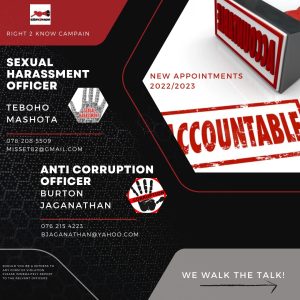Right2Know statement on police brutality and growing attacks on the right to protest
Mothotlung is a symptom of increasing police brutality and growing attacks on the right to protest
The protest and killings in Mothotlung are a symptom of the growing attacks to the right to protest in South Africa, fuelled by the militarisation of the police and criminalisation of protest.
The Right2Know Campaign mourns the deaths of three Brits residents killed during a protest for fresh water in Mothotlung, which had been without water for over a month. Mike Tshele and Osiah Rahube were shot at point-blank range during the protest, while Theodore Seema is alleged to have been pushed out of a moving Nyala and died of the injuries sustained. The Right2Know Campaign shares the nationwide outrage at the incident and joins the call for a full and independent inquiry into the incident and for officers responsible to face the consequences of their actions.”
It is equally urgent, however, to address why our police force is so violent in the first place. Why has the number of cases of police brutality risen by 313 % in the last 10 years (much of it while policing protests)? Is such police violence a result of the call made by the President himself, in his state of the nation address last year, and later by Minister Cwele in his budget speech, to police protests more vigilantly in order to curb “threats to national security”?
Too often media, civil society and government pay attention to the plight of the poor only once streets are barricaded and property destroyed. What is ignored is these are often the last act in long-simmering tensions that have no other avenue for ventilation.
Burning tyres, barricading streets and destroying property therefore become a language of necessity for the poorest of the poor who are otherwise not heard. Formal avenues for the expression of grievances have often become dysfunctional.
GROWING CRIMINALISATION OF PROTEST IS AN ATTACK ON FREEDOM OF EXPRESSION
Many communities active in the R2K Campaign complain that when they follow the Regulation of Gatherings Act to the letter, and deliver memoranda of grievances to the relevant institutions, they are simply ignored. This communicates the inevitable message that lawful methods of communicating grievances do not work; that the media and government will come running only if protestors burn tyres, erect barricades and burn down councillors’ houses.
Lawful channels such as the Ward/Councillor system through which their grievances could be ventilated have, in some instances, been closed off through corruption, politicking and incompetence. Furthermore, many municipalities have implemented legally dubious rules that make it difficult, if not impossible, for communities to exercise their right to protest lawfully, while at the same time requiring protests to fall within the ambit of the law.
These factors are forcing more and more people onto the streets anyway, leading to confrontations with the police, who perceive the protest to be ‘illegal’.
MILITARISATION OF POLICE IS A CATALYST FOR VIOLENCE
The Right 2 Know Campaign supports calls made by various organisations to demilitarise the police, as we believe that this is driving greater police violence, including against protestors. The increased use of paramilitary units to supplement protest policing is a case in point, as these units are mandated to use maximum force, rather than minimum force, as the public order police are. Furthermore, the current model of public order policing used by the SAPS is, in itself, highly paramilitarised.
DEFENDING THE RIGHT TO PROTEST AS FREEDOM OF EXPRESSION
In this context the right to protest must be regarded as a critical dimension of our Constitutional freedom of expression. We must all defend the right to protest with the same passion and vigilance we give to defending press freedom and other aspects of the freedom of expression.
Journalists have an important role to play in defending this freedom. Too many reports on the conflict in Brits have portrayed citizens as irrational and violent while often suggesting that the police act in the public interest or self-defence. What is not often recognised is the chain of cause and effect that precedes the protest, that usually starts with a community attempting to make their voices heard using more conventional means, but being repeatedly rebuffed.
Property destruction is often the tactic of last resort, rather than the tactic of first resort. It has been shown the world over that protests often turn violent in response to police violence, and not before that, and South Africa is no exception to this general trend. The term ‘violent service delivery protests’ has become a chime in the media, which may fail to expose how the protest got to be violent in the first place and who instigated the violence. Furthermore, property destruction should not be conflated with violence. If violence is understood correctly as ‘behaviour involving physical force intended to hurt, damage or kill’, then all too often the main perpetrators of violence during protests are the police.
Furthermore, many protests are not primarily about service delivery at all, but are about suffering the indignity of not being heard, or being misrepresented. Media caricatures of protests are dangerous, as they can feed inadvertently into moral panics about protests that can then be used by the authorities to repress protests under the guise of protecting the public.
The right to protest was at the heart of the democratic struggle for freedom. Mobilising brute force against unarmed individuals is an insult not just to the freedoms of expression and assembly enshrined in our Constitution. It is a rejection of the legacy of the struggle for which thousands paid the ultimate price.
For comment contact:
Murray Hunter: 0726725468
Bongani Xezwi: 0710432221
Jane Duncan: 0827863600



